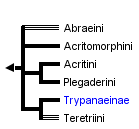Abraeinae
Michael S. Caterino


This tree diagram shows the relationships between several groups of organisms.
The root of the current tree connects the organisms featured in this tree to their containing group and the rest of the Tree of Life. The basal branching point in the tree represents the ancestor of the other groups in the tree. This ancestor diversified over time into several descendent subgroups, which are represented as internal nodes and terminal taxa to the right.

You can click on the root to travel down the Tree of Life all the way to the root of all Life, and you can click on the names of descendent subgroups to travel up the Tree of Life all the way to individual species.
For more information on ToL tree formatting, please see Interpreting the Tree or Classification. To learn more about phylogenetic trees, please visit our Phylogenetic Biology pages.
close boxIntroduction
Most of the Abraeinae have informally been referred to as the ‘microhisteridae’. This designation indicates the fact that many of the species of the group are tiny, with adults frequently <2mm in length. These include most members of the Abraeini, Acritini, Acritomorphini, and Plegaderini. However, species in the Teretriini and especially Trypanaeinae (still considered a subfamily, although undoubtedly a subordinate member of this group) can be much larger. Altogether this group contains about 500 described species. But given their small size, undoubtedly many remain to be discovered.
Most species of the group are associated in some way with rotting vegetation. Many species are found under the bark of dead and dying trees (especially Plegaderini and Acritini). Many are found in leaf litter. The Teretriini and Trypanaeinae are mainly cylindrical forms associated with the galleries of various woodboring beetles. A few species are known to be associated with ants’ nests. All are predaceous as far as is known.
Characteristics
Abraeinae are diverse in form. The size of the small oval species readily separates them from all other histerids except for the (possibly related) Bacaniini, which also tend to be extremely small. Teretriini and Trypanaeinae are cylindrical in form, ranging from 2-12mm. They can be separated from all other cylindrical histerids by the form of the antennal club, which is basally sclerotized and lacking in annuli (sutures). The principal synapomorphy for the entire Abraeinae is the lack of a separate basal piece of the aedeagus.
Discussion of Phylogenetic Relationships
The relationships among subgroups of Abraeinae are not well understood, due in part to the fact that the tribes and genera themselves are for the most part poorly defined. The one aspect of the tree shown here that is well supported, and somewhat radical, is the placement of Trypanaeinae within the group. Although a relationship close to Abraeinae has been gaining favor (e.g. Lawrence & Newton, 1995; Slipinski & Mazur, 1999), only recently has this been clearly demonstrated on the basis of larval, adult, and molecular data (Caterino & Vogler, 2002).
References
Caterino, M. S., and A. P. Vogler. 2002. The phylogeny of the Histeroidea. Cladistics 18(4):394-415.
Lawrence, J. F., and A. F. Newton. 1995. Families and subfamilies of Coleoptera (with selected genera, notes, references and data on family-group names). Pages 779-1006 in Biology, Phylogeny, and Classification of the Coleoptera: Papers Celebrating the 80th Birthday of Roy A. Crowson (J. Pakaluk, and S. A. Slipinsky, eds.). Muzeum i Instytut Zoologii PAN, Warsaw.
Slipinski, S. A., and S. Mazur. 1999. Epuraeosoma, a new genus of Histerinae and phylogeny of the family Histeridae. Annales Zoologici (Warszawa) 49:209-230.
Title Illustrations

| Scientific Name | Trypaneus junceus |
|---|---|
| Location | central America |
| Specimen Condition | Dead Specimen |
| Image Use |
 This media file is licensed under the Creative Commons Attribution-ShareAlike License - Version 3.0. This media file is licensed under the Creative Commons Attribution-ShareAlike License - Version 3.0.
|
| Copyright |
© 2002

|
About This Page

Santa Barbara Museum of Natural History, Santa Barbara, California, USA
Page copyright © 2002
 Page: Tree of Life
Abraeinae.
Authored by
Michael S. Caterino.
The TEXT of this page is licensed under the
Creative Commons Attribution License - Version 3.0. Note that images and other media
featured on this page are each governed by their own license, and they may or may not be available
for reuse. Click on an image or a media link to access the media data window, which provides the
relevant licensing information. For the general terms and conditions of ToL material reuse and
redistribution, please see the Tree of Life Copyright
Policies.
Page: Tree of Life
Abraeinae.
Authored by
Michael S. Caterino.
The TEXT of this page is licensed under the
Creative Commons Attribution License - Version 3.0. Note that images and other media
featured on this page are each governed by their own license, and they may or may not be available
for reuse. Click on an image or a media link to access the media data window, which provides the
relevant licensing information. For the general terms and conditions of ToL material reuse and
redistribution, please see the Tree of Life Copyright
Policies.
- First online 07 March 2002
Citing this page:
Caterino, Michael S. 2002. Abraeinae. Version 07 March 2002 (under construction). http://tolweb.org/Abraeinae/9385/2002.03.07 in The Tree of Life Web Project, http://tolweb.org/







 Go to quick links
Go to quick search
Go to navigation for this section of the ToL site
Go to detailed links for the ToL site
Go to quick links
Go to quick search
Go to navigation for this section of the ToL site
Go to detailed links for the ToL site